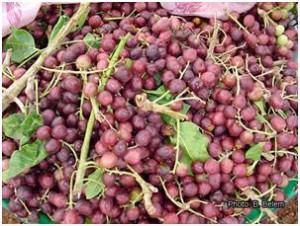Tree grapes (Lannea microcarpa) are actually in the same family as mangoes, cashews, and pistachios, but they look and taste more like grapes. And although they do not grow on vines, tree grapes hang from trees in grape-like bunches.

Tree grapes are often sold in both city street markets and along roadsides in West Africa. In Burkina Faso, the tree is cultivated commercially on a small scale and the trees can be seen in and around villages. The fruit can be eaten fresh or dried like raisins for longer-term storage. The fruit makes an excellent jam, can be made into wine, and the pulp fermented into a potent alcoholic drink. The tree’s young leaves are nutritious—18 percent protein and 5 percent minerals—and are eaten by both people and livestock. An edible and water-soluble gum can also be extracted from the tree.
The tree has important non-food uses as well. The seed kernel is high in oil, which is sometimes extracted and used to make soap and skin lotions. The fibrous bark can be made into rope, and a dark red-brown dye is also extracted from it. The bark is also used to treat diarrhea. Cloth dyed with this tree is often associated with healing, because of the medicinal properties of the bark and the blood-red color. The leaves, bark, roots, and fruits of this tree are applied to treat blisters, boils, sore throat, and rheumatism. The flowers are very attractive to bees, and beekeepers often hang their hives among the branches of this tree.
The trees are hardy and drought tolerant, and they can grow in harsh soil. These trees are also resistant to burning, and they are often undamaged by natural savannah fires. The tree grape is ideal for planting among crops in poor quality fields and in harsh climates, protecting crops from overexposure to the sun, preventing erosion, and supplementing crop yields with the fruit. They can also support food security and incomes of poor peri-urban communities on marginal land where other food crops have difficulty growing.
Little is known about the nutritional qualities of trees grapes. Research and development is needed to identify and select desirable and more nutritious varieties.

Danielle Nierenberg, an expert on livestock and sustainability, currently serves as Project Director of State of World 2011 for the Worldwatch Institute, a Washington, DC-based environmental think tank. Her knowledge of factory farming and its global spread and sustainable agriculture has been cited widely in the New York Times Magazine, the International Herald Tribune, the Washington Post, and
other publications.
Danielle worked for two years as a Peace Corps volunteer in the Dominican Republic. She is currently traveling across Africa looking at innovations that are working to alleviate hunger and poverty and blogging everyday at Worldwatch Institute’s Nourishing the Planet. She has a regular column with the Mail & Guardian, the Kansas City Star, and the Huffington Post and her writing was been featured in newspapers across Africa including the Cape Town Argus, the Zambia Daily Mail, Coast Week (Kenya), and other African publications. She holds an M.S. in agriculture, food, and environment from Tufts University and a B.A. in environmental policy from Monmouth College.








